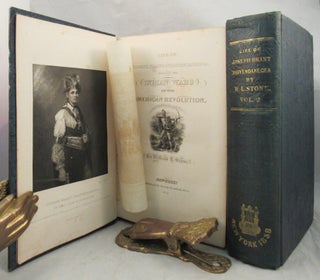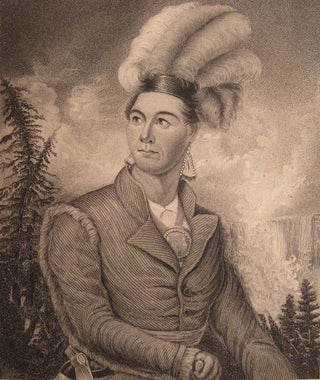LIFE OF JOSEPH BRANT - THAYENDANEGEA: Including the Border Wars of the American Revoloution, and Sketches of the Indian Campaingns of Generals Harmar, St. Clair, and Wayne. And Other Matters Connected with the Indian Relations of the United Sttes and Great Britain, from the Peace of 1783 to the Indian Peace of 1795
(New York: George Dearborn and Company, 1838).
FIRST EDITION AND A BOOK WHICH WAS CALLED "THE BEST BIOGRAPHY OF AN AMERICAN INDIAN". 'Thayendanegea or Joseph Brant was a Mohawk military and political leader, based in present day New York, who was closely associated with Great Britain during and after the American Revolution. Perhaps the Native American of his generation best known to the Americans and British, he met many of the most significant Anglo-American people of the age, including both George Washington and King George III.
While not born into a hereditary leadership role within the Iroquois League, Brant rose to prominence due to his education, abilities, and connections to British officials. His sister, Molly Brant, was the consort of Sir William Johnson, the influential British Superintendent of Indian Affairs in the province of New York. During the American Revolutionary War, Brant led Mohawk and colonial Loyalists known as "Brant's Volunteers" against the rebels in a bitter partisan war on the New York frontier. He was accused by the Americans of committing atrocities and given the name "Monster Brant", but the accusations were argued by later historians to have been false.
In 1784, Frederick Haldimand granted Joseph Brant and his followers a land treaty to replace what they had lost in New York State at the Sandusky Council after the Revolution. This tract, the Haldimand Grant, was about 810,000 hectares (2,000,000 acres) in size, 12 miles (19.2 kilometers) wide along the whole trace of the Ouse or Grand River in what is now southwestern Ontario. Chief Brant relocated with most of his people to Upper Canada to the area which is now Six Nations Reserve, where he remained a prominent leader.
Starting at about age 15 during the French and Indian War (part of the Seven Years' War), Brant took part with Mohawk and other Iroquois allies in a number of British actions against the French in Canada: James Abercrombie's 1758 expedition via Lake George that ended in utter defeat at Fort Carillon; Johnson's 1759 Battle of Fort Niagara; and Jeffery Amherst's 1760 expedition to Montreal via the St. Lawrence River. He was one of 182 Native American warriors awarded a silver medal from the British for his service.
During the siege of Fort Niagara, Brant served as a scout. Along with a force of British Army soldiers, New York militiamen, and other Iroquois warriors, he took part in an ambush of a French relief force at the Battle of La Belle-Famille, which may have been the first time that Brant saw action. The French force, while marching through the forest towards Fort Niagara, were annihilated during the ambush. On July 25, 1759, Fort Niagara surrendered. In 1760, Brant joined the expeditionary force under General Jeffrey Amherst, which left Fort Oswego on August 11 with the goal of taking Montreal. After taking Fort Lévis on the St. Lawrence, Amherst refused to allow the Indians to enter the fort, fearing that they would massacre the French prisoners in order to take scalps, which caused the majority of the Six Nations warriors to go home, as they wanted to join the British in plundering the fort. Brant stayed on and in September 1760 helped to take Montreal.
Johnson arranged for three Mohawk, including Brant, to be educated at Eleazar Wheelock's "Moor's Indian Charity School" in Connecticut. This was the forerunner of Dartmouth College, which was later established in New Hampshire. Brant studied under the guidance of Wheelock, who wrote that the youth was "of a sprightly genius, a manly and gentle deportment, and of a modest, courteous and benevolent temper". Brant learned to speak, read, and write English, as well as studying other academic subjects. He was taught how to farm at the school (considered to be woman's work by the Iroquois), math and the classics. Europeans were afterwards astonished when Brant was to speak of the Odyssey to them. Johnson prepared for Brant to attend King's College in New York City, but the outbreak of Pontiac's Rebellion upset his plans, and Brant returned home to avoid hostility toward Native Americans.
In 1775, he was appointed departmental secretary with the rank of Captain for the new British Superintendent's Mohawk warriors from Canajoharie. In April 1775, the American Revolution began with fighting breaking out in Massachusetts, and in May 1775, Brant traveled to a meeting at German Flatts to discuss the crisis. He participated with Howe's forces as they prepared to retake New York. Although the details of his service that summer and fall were not officially recorded, Brant was said to have distinguished himself for bravery. He was thought to be with Clinton, Cornwallis, and Percy in the flanking movement at Jamaica Pass in the Battle of Long Island in August 1776.[47] He became lifelong friends with Lord Percy, later Duke of Northumberland, in what was his only lasting friendship with a white man.
Brant was a war chief, and not a hereditary Mohawk sachem. His decisions could be and sometimes were overruled by the sachems and clan matrons. However, his natural ability, his early education, and the connections he was able to form made him one of the great leaders of his people and of his time. The situation of the Six Nations on the Grand River was better than that of the Iroquois who remained in New York. His lifelong mission was to help the Indian to survive the transition from one culture to another, transcending the political, social and economic challenges of one of the most volatile, dynamic periods of American history. He put his loyalty to the Six Nations before loyalty to the British. His life cannot be summed up in terms of success or failure, although he had known both. His attempt to create pan-tribal unity proved unsuccessful, though his efforts would be taken up a generation later by the Shawnee leader Tecumseh.' Wiki. Item #31727
2 volumes. First Edition, First Binding with "New York 1838". Illustrated with engraved title-pages, a number of engraved illustrations, portraits, plans and folding plates, complete. Tall 8vo, publisher's original blue floral cloth, the spines decorated and lettered in gilt. xxxi, 425, lvii; viii, 537, lxiv pp. complete with half-titles. A very pleasing set, handsome and unusually well preserved, especially for such a rare cloth binding of the period.


